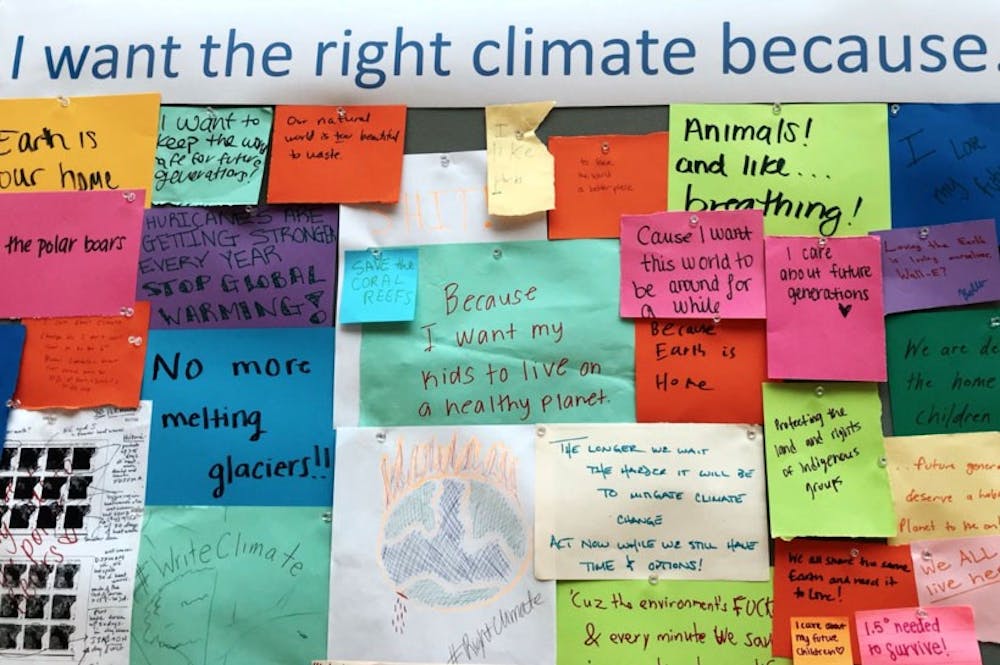Students in the course “Words on Paper: History of Climate Science, Policy and Art,” EVSC 1559, have been working all semester on an installation to raise awareness about climate change. The Write Climate exhibit was on display in the Mural Room of Clark Hall March 22-27.
This is the pilot semester of the course, which is taught by Environmental Science Prof. Deborah Lawrence. Lawrence said that the class consists of learning about climate science history, climate policy history and art and community engagement.
“We started out trying to understand the history of climate science,” Lawrence said. “We looked for the major turning points starting in 1824 when we first hypothesized about the greenhouse effect.”
According to Lawrence, after learning about the history of climate science, they studied the history of climate policy.
“We looked for the policy story, which is the other part, and that starts in the United States in 1955 with the first law on air pollution. . . and then we trace the arc of that climate policy story in our country,” Lawrence said. “Once we had these milestones, when we were looking at the texts, we were trying to say ‘what are the words that grab you?’”
Then, the students in EVSC 1559 started setting up tables at various locations on Grounds before Spring Break to raise awareness on climate change and engage a larger audience, according to second-year Engineering student Anna Cerf, who is in Lawrence’s class.
Lawrence said they tabled for three to four weeks, asking people to participate in writing about the climate story. They had various choices of prompts which people could respond to. Participants could write about a myriad of subjects, including a fact about the history of climate science history, the policy history, why they care about climate change or how they are mitigating their effect on climate change.
“I think the most interesting responses we got were what actions someone takes or what actions someone recommends taking to help address the issue,” said Samuel Mogen, a second-year College student in Lawrence’s class.
Similarly, Lawrence said that having people writing about climate change, rather than just talking about it, is very powerful.
“When you write something, your brain acts differently, and your brain responds differently and your heart responds differently,” Lawrence said. “You actually commit. We wanted to get people to commit with us.”
The class displayed these responses written on pieces of paper on bulletin boards in the Mural Room in Clark Hall. There was also a station in the installation where people could add to the collage.
Lawrence said that by showcasing the pieces of paper, the class aimed to move people by the number of responses and to raise awareness about climate change.
“We’re hoping to have a conversation about it to heighten awareness of the fact that we have known about climate change for a long time — 200 years,” Lawrence said. “We’ve not only done good science for a long time, we’ve also done good policy for a long time and it’s been across the board, it’s been bi-partisan, just part of who the United States of America is.”
Environmental Sciences Prof. Scott Doney said the exhibit was a good way of engaging people in an optimistic way and breaking down the polarizing debate that often surrounds discussions about climate change.
“It could give people a sense that they did actually have a voice and a possibility that they can lead to a better outcome,” Doney said.
In addition to fostering conversations about the history and importance of this issue, the display prompted students to write about what they can do to mitigate climate change.
Second-year College student Carly Starobin visited the display and said that allowing students to write about what they’ve done to reduce their personal effect on the climate provides ideas for other students who read it as well.
According to Lawrence, this was only the first step in the project— she has plans to expand it further. Next, the class is going to take these pieces of paper from the installation in Clark and create art as a group project.
For example, Cerf and second-year College student Jamie Wertz are in the same group in the class. Wertz said the group will use blue papers from the display to create an image of flooding due to rising sea levels against a city skyline.
“We’re going to show the potential impacts of climate change if action isn’t taken,” Cerf said.
In addition to the art projects, Lawrence said the class will participate in the Earth Week Expo: 100 Climate Solutions, which will be held in the Newcomb Ballroom April 17. She also plans to take the project off Grounds and work with high schools in the Charlottesville area to further share the climate story.
“So far, we’ve touched 1,000 people, and we hope to go even further,” Lawrence said.







